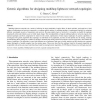Free Online Productivity Tools
i2Speak
i2Symbol
i2OCR
iTex2Img
iWeb2Print
iWeb2Shot
i2Type
iPdf2Split
iPdf2Merge
i2Bopomofo
i2Arabic
i2Style
i2Image
i2PDF
iLatex2Rtf
Sci2ools
AEI
1999
1999
Genetic algorithms for designing multihop lightwave network topologies
Multihop lightwave networks are a means of utilizing the large bandwidth of optical fibers. In these networks, each node has a fixed number of transmitters and receivers connected to a common optical medium. A multihop topology is implemented logically by assigning different wavelengths to pairs of transmitters and receivers. By using tunable lasers or receivers, it is possible to modify the topology dynamically when node failures occur or traffic loads change. The reconfigurability of logical multihop lightwave networks requires that optimal topologies and flow assignments be found. In this article, optimization of these logical topologies by genetic algorithms is investigated. The genetic algorithm takes topologies as individuals of its population, and tries to find optimal ones by mating, mutating and eliminating them. During the evolution of solutions, minimum hop routing with flow deviation is used to assign flows, and evaluate the fitness of topologies. The algorithm is tested w...
| Added | 22 Dec 2010 |
| Updated | 22 Dec 2010 |
| Type | Journal |
| Year | 1999 |
| Where | AEI |
| Authors | Cenk Gazen, Cem Ersoy |
Comments (0)

